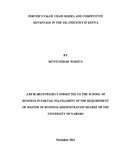| dc.contributor.author | Munyi, Eddah W | |
| dc.date.accessioned | 2013-02-26T09:46:03Z | |
| dc.date.issued | 2011 | |
| dc.identifier.citation | MBA Thesis | en |
| dc.identifier.uri | http://erepository.uonbi.ac.ke:8080/xmlui/handle/123456789/11603 | |
| dc.description | Porter’s value chain model and competitive advantage in the oil industry in Kenya | en |
| dc.description.abstract | The task of any business is to deliver customer value at a profit. In a hyper competitive
economy with increasingly rational buyers faced with abundant choices, a company can
win only by fine-tuning the value delivery process and choosing, providing, and
communicating superior value. Porter’s Value chain is a model used to study the
activities that are performed in the creation of a product or service by an organization.
These activities add value and cost in the process of creating products and services. The
activities may be classified as primary or secondary depending on whether they are the
core business or they are auxiliary functions of the firm. The goal of these activities is to
offer the customer a level of value that exceeds the cost of the activities, thereby resulting
in a profit margin. Sustainable competitive advantage is a situation where a firm is
capable of creating true value that is difficult for competitors to copy. A firm in this
situation is able to earn economic rents. The objective of this study was to determine how
a firm in oil industry in Kenya can utilize the value chain to create competitive
advantage. The oil industry in general is divided into two sections: upstream and
downstream operations. Upstream operations involve exploration and production works
that will to discovery and mining of petroleum. The main players in the petroleum sector
include the Kenya Pipeline Company (KPC), KPRL and the various petroleum
companies involved in the distribution of petroleum products commonly known as Oil
Marketing Companies (OMCs). The five major OMCs are Total Kenya, Kenol/Kobil,
Oilibya, Kenya Shell and the government owned National Oil Corporation of Kenya. The
study has been presented through five chapters and sections through which the researcher
has discussed the above issues. | en |
| dc.description.sponsorship | University of Nairobi | en |
| dc.language.iso | en | en |
| dc.title | Porter’s value chain model and competitive advantage in the oil industry in Kenya | en |
| dc.type | Thesis | en |
| local.embargo.terms | 6 months | en |
| local.publisher | School of Business, University of Nairobi | en |

